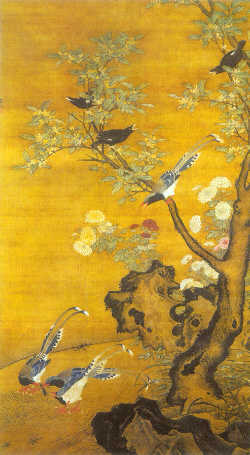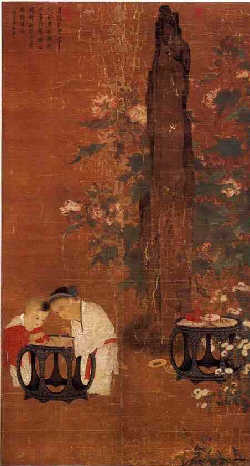Ancient Chinese paintings can be traced back to as early as 5,000 to 6,000 years ago, when people began to use minerals to draw simple pictures resembling animals, plants, and even human beings on rocks and produce drawings of amazing designs and decorations on the surface of potteries and laterbronzecontainers. However, only a few of the works have survived over time. The earliest drawings that have been preserved till today were produced onpaperand silk, which were burial articles with a history of over 2,000 years.
By Lu Ji,Ming Dynasty
As far as the subject is concerned, Chinese paintings fall into several categories, such as figure paintings, landscapes, andflower-and-bird paintings. European paintings, introduced into China in 17th century, were called "Western paintings," and the traditional local works, "the Chinese paintings."
As the representative of Eastern paintings, Chinese paintings greatly differ from the Western counterpart in terms of contents, forms, and styles. The following will give you a more vivid picture of the exotic Chinese paintings.
Colored Painting (gongbi) and Water-Ink Painting (xieyi)
In terms of drawing skills, Chinese paintings can be categorized into two styles: colored paintings and water-ink paintings, with the former dominant before the 12th century by professional or craftsman painters, and the latter in and after the 12th century by literati painters.
By Xu Wei, Ming Dynasty
Also known as "fine-stroke" paintings, colored paintings feature close attention to details and fine brushwork. Thanks to the mineral-made dyes, the original colors can be fully maintained and the paintings will not fade away as time goes by. Colored paintings, which manifest in themselves unparalleled sublime air, were widely welcomed among the painters serving in royal courts.
On the contrary, water-ink paintings, also called "thick-stroke" paintings, are supposed to convey spiritual resonance with strokes as simple as possible, instead of attaching much importance to the realistic subjects.
Exaggerated forms, such as generalization and hyperbole as well as rich imagination, are employed in painting to display painters' feelings. Therefore, it is relatively difficult to make a copy of a water-ink painting.
By Su Hanchen, Song Dynasty
Anyway, there is no absolute line between the two schools. No matter which school they belonged to, painters could and did compromise a little and learn from each other, giving rise to a mixed style including elements from both.













